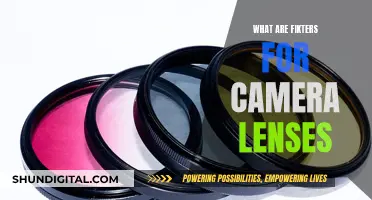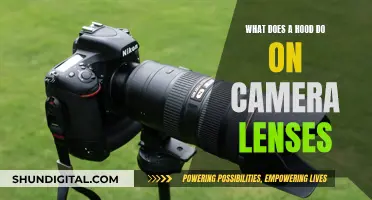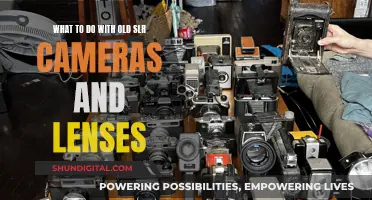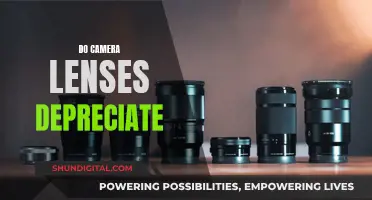
Camera lenses are complex pieces of machinery made up of many tiny parts. The process of assembling a camera lens involves bringing together various components, including the rear mount assembly, the iris, the lens element, the focusing ring, and the electrical connector strip. The rear mount assembly, which consists of interconnected washers, rings, and screws, plays a crucial role in connecting the lens to the aperture and enhancing the camera's stability. The iris, aptly named after the human eye, mimics its function by controlling the amount of light entering the lens. The lens element, on the other hand, can come in various shapes and sizes, such as convex, plano-convex, or biconvex, determining the direction of the curve. The focusing ring, found in manual cameras, allows photographers to adjust the focus, while modern digital cameras have an autofocus function. Lastly, the electrical connector strip facilitates communication between the lens and the camera body, enabling the lens to perform its functions.
| Characteristics | Values |
|---|---|
| Number of parts | Over 100 |
| Parts | Washers, rings, screws, iris, lens element, focusing ring, electrical connector strip |
| Lens element | Convex, plano-convex, biconvex |
| Iris | Automatic or manual |
| Focusing ring | Moveable |
| Lens mount | Bayonet or screw |
| Lens material | Glass, plastic, quartz glass, fluorite, acrylic, germanium, meteoritic glass |
| Lens coatings | Anti-reflective, UV, soap film, metallic fluorides |

Lens assembly basics
The camera lens is an invention that attempts to duplicate the operation of the human eye. It sees an image, focuses it, and transmits its colours, sharpness, and brightness through the camera to the photographic film, which records the image for future use. Lenses are made of optical glass or plastic, and they focus light rays by refracting or bending them so that they meet or converge at a common point.
A simple lens "sees" well through its centre, but its vision around the edges tends to blur. Blurring, colour changes, distortion of lines, and colour halos around objects are caused by defects in the lens called aberrations. Some aberrations can be corrected by shaping one or both surfaces so they are aspheric. A camera lens reduces the effects of aberrations by replacing a simple lens with a group of lenses called lens elements, which are lenses of different shapes and distances of separation. The lens becomes more complex as greater correction of vision is achieved.
Lens elements are usually described by their shape. The convex lens curves outward; a biconvex lens curves outward on both sides, and a plano-convex lens is flat on one side and outwardly curved on the other. There are also concave, biconcave, and plano-concave lenses. The elements are not necessarily symmetrical and can curve more on one side than the other. Thickening the middle of the lens relative to its edges causes light rays to converge or focus. Lenses with thick edges and thin middles make light rays disperse. A complex camera lens contains a number of elements specially grouped. The combination of the composition, shape, and grouping of the elements maximises the light-bending properties of the individual elements to produce the desired image.
The rear mount assembly is the section of the lens that connects it to the aperture. This is achieved through a series of interconnected washers, rings, and screws. This part of the lens assembly enhances the camera's stability, and failure to use one can damage the rest of the lens. The camera's iris, aptly named after the human eye, mimics the eye's function by limiting the amount of light that makes it into the lens. Cameras can be purchased with either automatic or manual focusing iris functions.
The electrical connector strip of the lens assembly joins the lens to the camera body. The lens is not mounted with the electrical connector strip, but the strip is how the lens "communicates" with the camera itself and allows it to perform its functions.
The lens in a compact camera is usually a general-purpose lens with a normal focal length that takes pictures of an image the way our eyes see it. Lenses designed for special purposes are used with more advanced cameras. Telephoto lenses work much like binoculars or telescopes, and make a distant image appear closer. Wide-angle lenses make the image appear farther away; a panoramic lens is a special kind of wide-angle lens that is useful for taking pictures of broad expanses of scenery.
Motorized Telescoping Lenses: Are They Reliable Camera Companions?
You may want to see also

Lens design
The design of a camera lens is a complex process that requires a blend of art and science. It begins by identifying the target market and the photographer who will use it. This could range from professional photographers to hobbyists, and even include specific photography styles like macro or landscape. Once the market is identified, the lens designer selects the optical and mechanical materials, the optical design, and the fabrication method.
The most commonly used materials for camera lenses are optical glass and plastic. Each has its advantages and disadvantages, affecting not just the lens's performance but also its price. Optical glass is known for its high light transmission and low distortion, while plastic is lightweight and cost-effective but may compromise image quality. Other materials used include quartz glass, fluorite, acrylic, germanium, and meteoritic glass.
The optical design of a camera lens involves assembling a group of lenses called lens elements. These are lenses of different shapes and distances of separation, which work together to correct optical aberrations and produce the desired image. The lens becomes more complex as greater correction of vision is achieved, and depending on the size of the aperture and the range of angles it "sees".
Lens elements are usually described by their shape. The convex lens curves outward, while the concave lens curves inward. There are also variations such as the biconvex lens, which curves outward on both sides, and the plano-concave lens, which is flat on one side and curved on the other. The elements can be asymmetrical and may curve more on one side than the other. The shape and grouping of the elements maximise the light-bending properties of the individual elements.
Today, computer programs play a crucial role in lens design, allowing for adjustments in the shaping and spacing of lens elements and determining their effects on each other. This has revolutionised the process, reducing the need for opticians' art and experimentation.
Target's Camera Lens Offerings: What You Need to Know
You may want to see also

Lens manufacturing
Camera lenses are typically made from glass, which has good optical properties and is resistant to scratching. Other materials used include quartz glass, fluorite, plastics like acrylic, and even germanium and meteoritic glass. The process of manufacturing a lens is complex and hands-on, which is why lenses are so expensive.
The first step in the manufacturing process is to mix glass powder in a large mixer. This powder is then melted into a liquid state. The molten glass is then squeezed into long glass strips, from which small squares are cut out. These squares are placed in a mould and melted in an oven. The lens body is then assembled with the glass inside.
Most lenses have over 100 parts that must be assembled separately. Lenses need to be specially optimised to minimise chromatic aberrations and artefacts. Different waves of light react differently with certain glass shapes, so careful design is important. While most consumer-grade lenses are spherical in design, professional lenses usually utilise an aspheric shape, making them curved instead of fully rounded.
Lenses also need to be able to change focus, which adds to the complexity of the manufacturing process. This requires multiple pieces of glass that can be moved back and forth within the lens body. If the lens is a zoom lens, even more complicated moving parts are required.
The design of a lens also depends on its intended use. For example, a wide-angle lens used for cinematography will have a different design from a lens used in a microscope. The designer must consider factors such as cost, weight, and materials when creating a lens for a specific purpose.
Cleaning Camera Lenses: A Step-by-Step Guide
You may want to see also

Lens testing
- Examine the lens barrel: Check for any loose sections, screws, or rattling sounds. Ensure that the filter ring is secure and cannot be rocked. Also, check if the internal barrel slides smoothly when zooming and focusing.
- Test the focusing mechanism: Set the lens to manual focus and move the ring back and forth smoothly. Note the part of the lens that moves during focusing and whether it rotates. If it's a zoom lens, check the focusing at both extremes.
- Evaluate the zoom mechanism: Ensure the zoom mechanism is smooth and there are no sudden catches or high resistance areas. If the front element extends, make sure the internal barrel is clean and free of scratches.
- Inspect the glass and internals: Look for scratches, coating defects, or internal dust and debris. Pay close attention to the rear element as flaws here can impact image quality significantly.
- Test the mounting ring: Mount and dismount the lens several times to ensure it goes on easily but firmly. Check if the locking pin catches properly and releases easily when the dismount button is pushed.
- Check autofocus accuracy: Use a single focus point and autofocus on a distant, detailed subject. Take photos with the lens at its widest aperture, then change the composition to move the subject to each corner of the frame. Compare the images to identify any significant differences in sharpness.
- Evaluate aperture performance: For lenses with a manual aperture ring, rotate the ring to check for smooth movement and consistent aperture shape. For lenses without an aperture ring, mount the lens to the camera and switch to video mode to observe the aperture at different values.
- Inspect for damage and dust: Use a light source to check the front and rear elements for dust, fungus, and scratches. Also, examine the aperture lever and lens mount contacts for any signs of corrosion or damage.
- Test zoom, focus, and stabilization mechanisms: Zoom through the range and check for any sticking or grit in the focus ring. Test the function switches and lens buttons. Evaluate the image stabilization system by enabling and disabling it to see if it "docks" correctly.
- Compare test images: After taking test shots, compare the images by zooming in on the centre and corners to evaluate sharpness, vignetting, and symmetry. Take notes on the lens's performance at different apertures and focal lengths.
Camera Lenses: Retaining Value Over Time?
You may want to see also

Lens types
The lens is the most important part of a camera, as it determines the aperture range, depth of field, and focusing distance. There are two main types of camera lens: zoom lenses and prime lenses. Zoom lenses have variable focal lengths, while prime lenses have a fixed focal length. Zoom lenses are incredibly versatile and are used for anything from street photography to wildlife. Prime lenses, on the other hand, are specialised and finely tuned to deliver on one specific type of photography. They produce much higher-quality images than zoom lenses but are limited in their use cases.
Prime lenses are also known as standard or normal lenses. They are versatile and can be used for everyday photography, including portraits, street photography, and documentary work. They render a perspective similar to that of the human eye and are good for achieving natural-looking images without significant distortion. Examples include 35mm, 50mm, and 85mm lenses.
Telephoto lenses are ideal for wildlife, sports, and event photography. They offer a narrow field of view, bringing distant subjects closer and isolating them from the background. They compress perspective, making distant elements appear closer together. Examples include 100mm up to 600mm, sometimes even more.
Wide-angle lenses are ideal for landscape photography, architecture, and real estate. They capture a broader field of view, allowing more of the scene to be included in the frame. They reduce perspective distortion and the exaggeration of subjects close to the lens. Examples include 14-24mm and 16-35mm lenses.
Macro lenses are perfect for close-up details of small subjects like insects, flowers, or products. They provide high magnification and excellent sharpness for extreme close-ups. Examples include 60mm, 100mm, and 105mm lenses.
Fisheye lenses are ultra-wide-angle lenses with a field of view of up to 180 degrees or more, creating a very unusual perspective with noticeable distortion. They are used for sports, parties, or real estate photography.
Specialty lenses include tilt-shift lenses, which are used in architectural photography to control perspective distortion and depth of field.
The Impact of Constant Lens Usage on Camera Performance
You may want to see also
Frequently asked questions
Camera lenses are made of optical glass or plastic.
Camera lenses focus light rays by refracting or bending them so that they meet or converge at a common point.
The different parts of a camera lens include the rear mount assembly, the iris, the lens element, the focusing ring, and the electrical connector strip.







